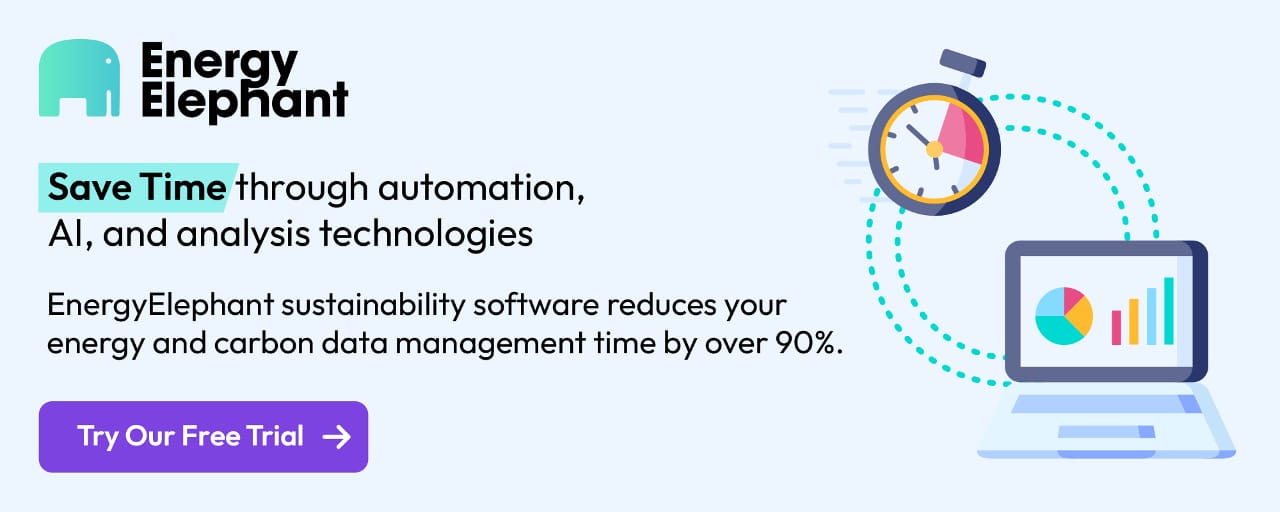Scope 4: A critical piece of the net-zero puzzle
Measuring and reporting Scope 4 (avoided emissions) can help organisations articulate their positive contribution to system-wide decarbonisation beyond merely lowering their operational footprint. The data can be used to inform strategic decision-making, as well as attract capital and investment.

Currently, greenhouse gas (GHG) emissions – as defined by the GHG Protocol (GHGP) – fall into three main categories for quantifying and disclosing an organisation's carbon footprint. These include:
- Scope 1: Direct emissions from operations
- Scope 2: Indirect emissions from purchased electricity, heat, or cooling
- Scope 3: All other indirect emissions that occur in an organisation's supply chain, both upstream and downstream, as well as embodied carbon
While the focus has traditionally been on managing and reducing direct and indirect emissions, there is a growing recognition that avoided emissions are a critical lever for accelerated, system-wide decarbonisation at a global level.
Enter Scope 4
A few years ago, the GHGP raised the idea of a Scope 4 to enable the calculation of emissions avoided when a product is used as a substitute for other goods or services, fulfilling the same functions but with a lower carbon intensity, also taking into account emissions avoided when a product is recycled.
Subsequently, various methodologies and international standards have started to address the subject. Although not formally recognised within the GHGP's carbon accounting methodology just yet, the growing interest in Scope 4 stems from a shift in how organisations and financial markets view climate action.
What are Scope 4 avoided emissions?
Scope 4 emissions are not directly associated with the production or supply chain of a product or service, but rather with the consequences of its use. For example, if a more energy efficient appliance is used instead of a less efficient one, the difference in energy consumption – and thus emissions – would be considered a Scope 4 avoided emission.
Who is responsible for reporting Scope 4 emissions?
Since the avoided emissions are a result of the manufacturer's product or service, it is their responsibility to track and report on these benefits. They need to demonstrate how their product/service leads to emission reductions compared to a baseline scenario, which can be quite complex and open to interpretation.
While the manufacturer is the primary reporter, they may need to engage with their suppliers to gather information on the materials, components, or processes used in their product, which can be helpful in understanding the overall impact and potential for further reductions. However, the overall responsibility for reporting Scope 4 emissions remains with the manufacturer.
Value of Scope 4 as a metric
Being able to quantify the lifecycle difference in emissions impact of a product or service compared to a baseline scenario provides a much more comprehensive view of an organisation’s impact on the environment. The data can be used to:
- Demonstrate Broader Climate Impact: Scope 4 allows organisations to articulate their positive contribution to system-wide decarbonisation beyond merely lowering their operational footprint. It highlights how an organisation’s innovative products and services help other actors (e.g. customers, consumers, other organisations) reduce their own emissions.
- Inform Strategic Decision-making and Innovation: Assessing avoided emissions can provide valuable insights for internal decision-making processes, such as R&D prioritisation, product development, and identifying markets with the highest decarbonisation potential. It helps organisations make informed choices that maximise their positive climate impact and strengthen their competitive position as solution providers in the net-zero transition.
- Attract Capital and Investment: Financial actors are increasingly adopting avoided emissions as a metric to evaluate climate-aligned opportunities and steer capital toward impactful sustainability solutions. Impact investors, in particular, view Scope 4 as a crucial metric for assessing the value of an organisation and its potential for positive environmental outcomes.

Examples of Scope 4 avoided emissions
- Teleconferencing Systems: A software company provides high-quality video conferencing tools, reducing the need for business travel. With more employees working remotely, emissions related to travel are greatly reduced.
- High-efficiency LED Lighting: A lighting company designs LED bulbs that use less energy than incandescent ones. These energy savings in homes and businesses translate into lower electricity consumption and reduced emissions from energy production.
- Energy-efficient Appliances: A company manufactures energy-efficient refrigerators that consume less electricity than traditional models. This leads to energy savings for users and a decrease in emissions from electricity generation. As energy bills drop, so does the demand for fossil fuel-based energy, resulting in lower emissions.
- Smart Water Management Systems: Technologies such as smart irrigation and water-efficient appliances help conserve water. These solutions also reduce the energy needed for water pumping and treatment, indirectly cutting emissions.
- Renewable Energy Systems: A company produces and installs solar panels for residential and commercial use. These systems displace fossil fuel-based electricity, significantly cutting emissions as solar energy takes its place.
- Electric Vehicles (EVs): Replacing internal combustion engine vehicles with electric ones significantly lowers transport-related emissions. This includes not just emissions during operation but also those from petroleum extraction, refining, and distribution.
- Fuel-efficient Tyres: A manufacturer creates tyres that improve fuel efficiency by lowering rolling resistance. This results in reduced fuel consumption and fewer emissions from vehicle use.
Alternative Scope 4 emission categorisations
While the most common interpretation of Scope 4 refers to avoided emissions, it has also been used unofficially to describe other alternative emission categorisations. These include:
- Advertised Emissions: Environmental costs associated with the aggressive marketing tactics of low-cost, high-volume, high-waste retailers, especially in the ultra-fast fashion space. Using psychological triggers and influencer culture to promote over-consumption of carbon-intensive goods contributes to higher lifetime carbon footprints per customer. France is pioneering policy efforts to disrupt this cycle, positioning itself as a model for how advertising regulations can serve as climate tools – not just consumer protections.
- Advised Emissions: Emissions associated with the provision of legal advice or services to high-emitting sectors (e.g. legal support for fossil fuel projects could increase emissions, while support for renewable energy projects could reduce them).
- Enabled Emissions (Consulting): Emissions that result from advice or services provided by consultants that contribute to increased production, resource extraction, or activities with significant carbon footprints.
- Locked-in Emissions (Engineering/Design): Emissions tied to decisions that an engineer or architect may influence (e.g. material selection and manufacturing processes). Unlike operational carbon, which can be reduced over time through energy efficiency improvements, embodied carbon is locked into the building from the moment materials are produced and assembled.

Challenges in measuring & reporting Scope 4
Despite its benefits, measuring and reporting avoided emissions is complex, and presents several challenges. These include:
- Unofficial Status and Lack of Standardisation: While several guidance documents do exist (see 'Scope 4 guidance & frameworks' below), there is currently no universally accepted standard for measuring and reporting Scope 4 emissions, which can lead to varying interpretations and methodologies across different industries and sectors.
- Complexity of Calculation: Credible calculations require careful consideration of the full boundary of emission impacts. This involves establishing a baseline of emissions for the traditional activity or product being replaced, and conducting a comparative lifecycle assessment (LCA) to evaluate all stages of environmental impact for both the solution and the baseline.
- Defining the Reference Scenario: The reference scenario, representing the most likely situation without the low-carbon solution, is hypothetical and can be difficult to define accurately. It depends heavily on the market context, whether the solution addresses new or existing demand, and if it's an improvement or replacement.
- Data Availability and Quality: Accurate assessment relies on high-quality data for both the solution and the reference scenario across their entire lifecycle (e.g. transport, production, use, end-of-life). Obtaining primary, site-specific data can be challenging, especially for activities outside an organisation's direct control or for the use phase of products. Assumptions are often necessary, introducing uncertainty.
- Dynamic Nature and Forecasting: Avoided emission assessments often involve estimations over several years, requiring consideration of dynamic factors like forecasted electricity decarbonisation or technological improvements. Forward-looking assessments, while valuable, inherently involve higher uncertainty due to reliance on predictions.
- Double Counting and Attribution Challenges: When multiple organisations or components contribute to the same avoided emissions (e.g. an intermediary solution contributing to an end-use solution), there is a risk of double counting. Allocating avoided emissions across different value chain actors can be highly uncertain.
- Risk of Greenwashing: A concern is that organisations might use avoided emissions to divert attention from their own Scope 1, 2, and 3 emissions, or to make misleading claims of carbon neutrality. Robust and transparent methodologies are crucial to ensure claims are credible and science-aligned.
Scope 4 guidance & frameworks
Although we are yet to see a single global standard for Scope 4 reporting, Guidance on Avoided Emissions v2.0: Drive Innovations and Scale Solutions Toward Net Zero is the latest and most comprehensive document available.
Published in July 2025 by the World Business Council for Sustainable Development (WBCSD), the content has been updated to better support organisations and investors who want to assess and communicate the impact of their low-carbon solutions and portfolios beyond the GHG inventory footprint.
It provides a robust, science-aligned methodology to quantify and disclose avoided emissions, so organisations, investors, and policymakers can scale climate solutions with integrity and transparency.
2025 updates in WBCSD 'Guidance on Avoided Emissions'
- Standardised templates and best practices to support transparent disclosure, impact validation, and third-party review.
- Alignment with global standards and frameworks, like the GHGP, IPCC, PCAF and ISO.
- Sector-specific guidance, a technical template for assessment and disclosure, and a growing library of real-life use cases in an open access Avoided Emissions Implementation Hub.

